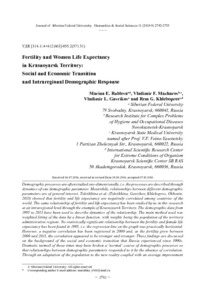Показать сокращенную информацию
Fertility and Women Life Expectancy in Krasnoyarsk Territory: Social and Economic Transition and Intraregional Demographic Response
| Автор | Rubleva, Marina E. | en |
| Автор | Mazharov, Vladimir F. | en |
| Автор | Gavrikov, Vladimir L. | en |
| Автор | Khlebopros, Rem G. | en |
| Автор | Рублева, М.Е. | ru_RU |
| Автор | Мажаров, В.Ф. | ru_RU |
| Автор | Гавриков, В.Л. | ru_RU |
| Автор | Хлебопрос, Р.Г. | ru_RU |
| Дата внесения | 2016-11-30T03:05:14Z | |
| Дата, когда ресурс стал доступен | 2016-11-30T03:05:14Z | |
| Дата публикации | 2016-11 | |
| URI (для ссылок/цитирований) | https://elib.sfu-kras.ru/handle/2311/29974 | |
| Аннотация | Demographic processes are often studied one-dimensionally, i.e. the processes are described through dynamics of one demographic parameter. Meanwhile, relationships between different demographic parameters are of general interest. Tolstikhina et al. (Tolstikhina, Gavrikov, Khlebopros, Okhonin, 2013) showed that fertility and life expectancy are negatively correlated among countries of the world. The same relationship of fertility and life expectancy has been studied by us in this research at an intraregional level through the example of Krasnoyarsk Territory. The demographic data from 1995 to 2013 have been used to describe dynamics of the relationship. The main method used was weighted fitting of the data by a linear function, with weights being the population of the territory administrative regions. No statistically significant relationship between the fertility and female life expectancy has been found in 1995, i.e. the regression line on the graph was practically horizontal. However, a negative correlation has been registered in 2000 and, as the fertility grew between 2000 and 2013, the correlation appeared to be stronger and stronger. These findings are discussed on the background of the social and economic transition that Russia experienced since 1990s. Dramatic turmoil of those times may have broken a ‘normal’ course of demographic processes so that relationships between demographic parameters responded to it by the absence of correlation. Through an adaptation of the population to the new reality coupled with an average improvement of social and economic situation the correlation between the demographic parameters restored and took the shape that is characteristic of the world countries dataset | en |
| Аннотация | Рассматривается демографическая ситуация в Красноярском крае в период с 1995 по 2013 г. В статье используются методы вычисления параметров линейной регрессии между ожи- даемой продолжительностью жизни и фертильностью женщин, проведена процедура «взве- шивания» демографических показателей. Обнаружено, что Красноярский край и в период социально-экономических трансформаций 1990-х и 2000-х годов следует общемировой тен- денции, характеризующейся обратной зависимостью между ожидаемой продолжительно- стью жизни и фертильностью женщин. Выявлено, что значимая зависимость между ис- следованными демографическими показателями может нарушаться и восстанавливаться в процессе адаптации к новым условиям жизни как в городских, так и в сельских муниципальных образованиях | ru_RU |
| Язык | en | en |
| Издатель | Сибирский федеральный университет. Siberian Federal University. | en |
| Тема | Krasnoyarsk territory | en |
| Тема | demography | en |
| Тема | life expectancy | en |
| Тема | general fertility rate | en |
| Тема | fertility | en |
| Тема | municipal units | en |
| Тема | social and economic transition | en |
| Тема | Красноярский край | ru_RU |
| Тема | демография | ru_RU |
| Тема | ожидаемая продолжительность жизни | ru_RU |
| Тема | специальный коэффициент рождаемости | ru_RU |
| Тема | фертильность | ru_RU |
| Тема | муниципальные образования | ru_RU |
| Тема | социально-экономическая трансформация | ru_RU |
| Название | Fertility and Women Life Expectancy in Krasnoyarsk Territory: Social and Economic Transition and Intraregional Demographic Response | en |
| Альтернативное название | Фертильность и ожидаемая продолжительность жизни женщин в Красноярском крае: внутрирегиональный демографический отклик на фоне социально-экономических трансформаций | ru_RU |
| Тип | Journal Article | |
| Тип | Published Journal Article | |
| Контакты автора | Rubleva, Marina E.: Siberian Federal University 79 Svobodny, Krasnoyarsk, 660041, Russia; E-mail: marishka_6500@mail.ru | en |
| Контакты автора | Mazharov, Vladimir F.: Research Institute for Complex Problems of Hygiene and Occupational Diseases Novokuznetsk-Krasnoyarsk; Krasnoyarsk State Medical University named after Prof. V.F. Voino-Yasenetsky 1 Partizan Zheleznyak Str., Krasnoyarsk, 660022, Russia | en |
| Контакты автора | Gavrikov, Vladimir L.: Siberian Federal University 79 Svobodny, Krasnoyarsk, 660041, Russia | en |
| Контакты автора | Khlebopros, Rem G.: Siberian Federal University 79 Svobodny, Krasnoyarsk, 660041, Russia; International Scientific Research Center for Extreme Conditions of Organism Krasnoyarsk Scientific Center SB RAS 50 Akademgorodok, Krasnoyarsk, 660036, Russia | en |
| Контакты автора | Рублева, М.Е.: Сибирский федеральный университет Россия, 660041, Красноярск, пр. Свободный, 79 | ru_RU |
| Контакты автора | Мажаров, В.Ф.: НИИ комплексных проблем гигиены и профессиональных заболеваний Новокузнецк–Красноярск; Красноярский государственный медицинский университет им. проф. В.Ф. Войно-Ясенецкого Россия, 660022, Красноярск, ул. Партизана Железняка, 1 | ru_RU |
| Контакты автора | Гавриков, В.Л.: Сибирский федеральный университет Россия, 660041, Красноярск, пр. Свободный, 79 | ru_RU |
| Контакты автора | Хлебопрос, Р.Г.: Сибирский федеральный университет Россия, 660041, Красноярск, пр. Свободный, 79; Международный научный центр исследований экстремальных состояний человека при Президиуме Красноярского научного центра СО РАН Россия, 660036, Красноярск, Академгородок, 50 | ru_RU |
| Страницы | 2742-2755 | |
| Журнал | Журнал Сибирского федерального университета. Гуманитарные науки. Journal of Siberian Federal University. Humanities & Social Sciences;2016 9 (11) | en |

